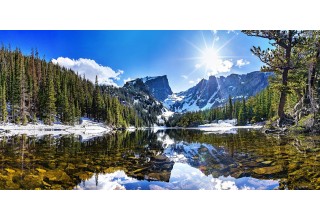Stop and Stare: National Parks and Monuments Along the Colorado Historic Hot Springs Loop
While traveling the Colorado Historic Hot Springs Loop, stops at National Monuments and Parks highlight the 720-mile journey, making for historic, cultural, and bewildering exploration.

National Parks came to be in 1933, when President Franklin D. Roosevelt signed an executive order adding 56 designated lands into the new service, both protecting lands and giving the public access to them. Since then, the system has rapidly expanded, including more than 400 areas of parks and monuments spanning across 84 acres in the continental US and its territories.
Colorado, thanks to its geographic diversity, is home to several National Parks and National Monuments. The Colorado Historic Hot Springs Loop, which spans over 720 miles connecting five premier locations, brings visitors through parks and to monuments. These natural wonders are perfect for exploration before stopping at the next prime soaking destination.
- Browns Canyon National Monument. Due to its close proximity to Salida, Buena Vista, and Nathrop, Browns Canyon National Monument is perfect for a pre-soak expedition. The area is one of the nation’s most popular whitewater rafting locations, and hosts all that the Arkansas River has to offer. Wildlife, including bighorn sheep, elk, deer, and eagles, call the canyon home, and recreation such as camping, biking, hiking, and rock climbing give visitors a peek into the animals’ natural habitat. The Collegiate Peaks Scenic and Historic Byway is a direct passage to explore Browns Canyon, as well as admire the towering peaks above.
- Black Canyon of the Gunnison National Park. Near Ouray, catch a drive through the Black Canyon of the Gunnison. This 53-mile stretch winds through a narrow gorge, with plummeting walls and dramatic views down. The Denver and Rio Grande railroad once traveled on rails throughout the canyon, and stray tracks can still be seen. Across the Black Canyon, there are opportunities for camping, hiking (Hermit’s Rest is a local favorite), auto touring, wildlife viewing, kayaking, horseback riding, fishing, cross-country skiing, and snowshoeing. Get your thrills before seeking out geothermal rest and relaxation.
- Colorado National Monument. Marrying desert plateaus and high mesas, the Colorado National Monument is a natural wonder of rock arches, cliff walls, and abundant wildlife in Grand Junction, Colorado. Wander through several trails that take hikers to the top, or take the 23-mile Rim Rock Drive, which takes travelers along the Monument and shows off the unique geological formations, carved by wind and water over centuries. It’s only an hour and a half away from Glenwood Springs, and two hours from Ouray, where luxurious hot springs await.
- Rocky Mountain National Park. Not far from Steamboat Springs, Rocky Mountain National Park encompasses the grandeur and beauty of the mountain region. High alpine lakes, evergreen forests, and towering peaks fill the 415-square miles of the park, known for its thousands of acres of wildlife and tranquil beauty. Visitors enjoy hiking (Grand Lake is a popular option), taking drives (Trail Ridge Road is the highest continuous paved road in the United States, at 12,183 feet), camping, and exploring nearby towns (Estes Park is known for its resident elk). After venturing into the Colorado wilderness, a short drive to hot springs completes an adventurous day.
- Chimney Rock National Monument. Chimney Rock, one of the country’s newest National Monuments, takes visitors into the area’s beginning. The Pagosa Springs site features ancient Puebloan ruins, guided tours, moon-lit education programs, and Native American Festivals, hoping to preserve the rich history in the area. Additionally, at the northern major lunar standstill, which takes place every 18.6 years, the moon rises between Chimney Rock and Companion Rock, making the national monument a natural observatory. The next major lunar standstill will take place in April 2025. Be sure to schedule a tour (www.chimneyrockco.org) before soaking at the three Pagosa Springs hot springs.
- Great Sand Dunes National Park. Towers of sand sit near the town of Alamosa, the tallest standing at 750 feet. This National Park is full of 30 miles-worth of sand dunes, waiting to be discovered. There are opportunities for hiking, four-wheel driving, and even sledding or sand-boarding down the dunes, with rental equipment available from local retailers. After a gritty morning, look forward to the soaking stylings of neighboring Pagosa Springs.
- Mesa Verde National Park. Mesa Verde is located in southwest Colorado, a quick drive from Pagosa Springs. The park is filled with incredibly preserved Ancestral Puebloan dwellings, offering peeks into the ancient culture and the daily lives of those who once called the area home. Visitors can tour different cliff dwellings—climbing in and out of enclaves and buildings—while admiring the park rangers’ stories. After, feel free to spread these stories at the nearby hot springs, to further extend and expand the history.
For more information on the Colorado Historic Hot Springs Loop, please visit www.colorado.com/hotspringsloop.
Categories: Travel, Vacations and Travel, Car Travel
Tags: CHHSL, Chimney Rock, Colorado Historic Hot Springs Loop, Colorado hot springs, Colorado national parks, Colorado road trip, Great Sand Dunes, hot springs, Mesa Verde, national monuments, road trip
Additional Images
Colorado Historic Hot Springs Loop Project Manager






